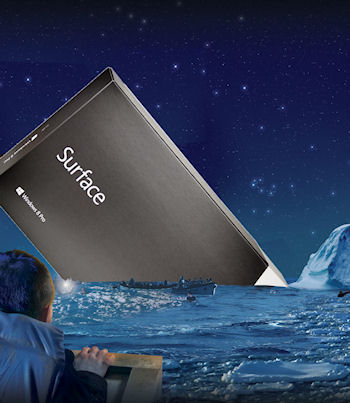Will Microsoft’s Hardware Deal Ever Surface In The Channel?

Microsoft’s Surface marketing has been a disaster and it may now have missed the boat in the channel
At the Microsoft Worldwide Partner Conference, the subject of tablets has been kept below the surface even though Windows 8 was top of the agenda. It’s a sore point with many of the partners that they cannot supply Surface systems because they can’t promise customers the full support they require. And yet, CEO Steve Ballmer skirted round the subject in his keynote.
The marketing of Microsoft’s response to the iPad’s phenomenal rise has been flawed from the beginning by an apparent conviction on the part of the Seattle giant that the world would beat a path to its door to lay hands on the hardware. The thinking appears to be that Apple succeeded in building its market by targeting the consumer, so why shouldn’t Microsoft?
Padding around aimlessly
Did nobody at Microsoft step back and take in the big picture? The company has a reputation for providing great business-focused systems and Surface Pro is the latest addition to this heritage. Surface RT is a good companion for those who have less demanding requirements.
Traditionally, Apple has lacked easy integration into the business environment and for many years its computers provided plenty of opportunities for systems integrators to make a few quid. The same has been true of the iPad but a plethora of business apps, combined with the cachet of the brand, has made it a popular BYOD option – but a major headache for the IT department.
Despite Apple’s business integration blind spot, Microsoft has shied away from the reseller market. Under the spell of the Apple business model, it has made the classic mistake of imitation rather than innovation – the same error that brought about the demise of its own competitors in the past, such as Digital Research and Novell.
It not only copied Apple’s, or should that be Dell’s, direct supply channel but also tried to launch its own US Microsoft Stores on the high streets of Canada, the US and Puerto Rico. With a lack of outlets outside North America, the direct sales model was supplemented by select retail partners, such as the John Lewis chain in the UK, being allowed to sell Surface – but only this month has it started toying with resellers in the enterprise markets.
At the moment, these partners are limited to US distribution channels (Ingram Micro, Synnex, and Tech Data) with a vague promise that the model will be rolled out worldwide if it proves successful. The tentative policy makes Microsoft look like a child who, having already burnt its fingers, starts poking about with great caution.
The company seems oblivious to the fact that the US market is Apple’s strongest territory and that the European market is probably a softer target and more open to trying something different.
Distributors and resellers hate to see a money-making opportunity go begging but this has been the Surface story. There is nothing more stifling and claustrophobic than a closed mind. Ballmer is running Microsoft’s sales engine on fixed rails but Surface needs an all-terrain vehicle to ramp up sales and find its place in the market.
From a business perspective, Surface is arguably better than an iPad. In the fashion stakes, if Apple is Abercrombie & Fitch, then Microsoft is Burberry, a former fashionable outlet fighting for rebirth. Unlike Burberry, Microsoft has yet to crack the mould.
It not only missed its vocation and failed to bring RT in at a must-have price point but has possibly missed, and miffed, its loyal channel members and their desire to offer a all-Microsoft BYOD infrastructure.